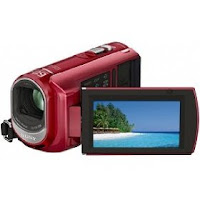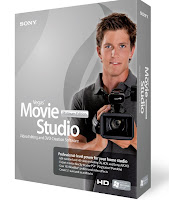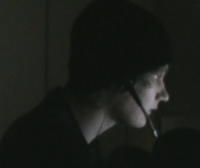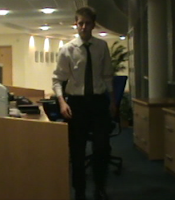1. In what ways does your media product use, develop or challenge forms and conventions of real media products?
2. How does your media product represent particular social groups?
3. What kind of media institution might distribute your media product and why?
4. Who would be the audience for your media product?
5. How did you attract/address your audience?
6. What have you learnt about technologies from the process of constructing this product?
7. Looking back at your preliminary task, what do you feel you have learnt in the progression from it to the full product?
1. There are many ways my media product uses, develops and challenges the forms and conventions of that from real media products, such as my storyline, genre and the representation of the characters. The Mise-En-Scene of my media product was the most important part of making it realistic and authentic like existing media products of this type such as The Bourne Ultimatum which we researched. Our storyline was the main thing that distinguishes our media product as that of existing ones as appose to a home movie. The whole idea of stealing government files, and secret agents makes it seem more realistic to the suited genre. Another thing is the representation of the characters; we based our characters on that seen in the existing openings we have studied, in the pictures below you can see how our opening is similar to that of the The Bourne Ultimatum's.

The pictures highlighted in red are that from our media product, and the pictures to the side or above them are stills taken from the Bourne films. As you can see, the sets of pictures are almost identical, showing how our media product uses, develops and challenges the forms and conventions of that from real media products.
2. My media product represents particular Social Groups such as our target audience of males aged between 15-50. This is because of the genre of our opening, which is action. Films of this genre are usually watched more by male audiences in my specific age range simply because they look up to the characters they see and the things they do, and aspire to be like them. This is why all of the characters in our opening are Males, so our target audience can relate to them. Our media product also contains mainly male orientated activities within the storyline such as fighting, guns, secret agents and freerunning which is a male dominated art/sport. The age we have portrayed our characters as being, which is around 20-30, also represents people of that age group which are in the age range of our target audience. 3. The main type of media institution that might distribute my media product will be that of low budget British institutions such as Film4 or BBC Films.
3. The main type of media institution that might distribute my media product will be that of low budget British institutions such as Film4 or BBC Films.
Film4 is a film production institution, owned by Channel 4, and is responsible for creating masterpieces such as Academy Award winning 'Slumdog Millionaire' and the story of a footballing legend, 'Looking For Eric'. Film4 develop and co-finance smart and distinctive feature films which is why they would be an institution to distribute a media product such as mine. Another British based film institution is that owned by the BBC, another popular channel of British television. BBC Films have released films such as 'The Men Who Stare At Goats' and 'The Damned United', which are popular low budget British films.
4. The target audience for my product is mainly males between the ages of 15-50, as research shows this group of people usually enjoy action films the most. The fast pace action scenes, containing chases, fights and explosions etc, usually attract younger males because they look up to the characters they see acting within these types of films. When deciding on the ideal target audience, it is important to think about if the content of the film is suitable for certain age groups. The BBFC (British Board of Film Classification) was set up in 1912 and is an independent, non-governmental body that oversees all film content, and puts classifications on it before it is released to cinema or video/dvd.
When deciding on the ideal target audience, it is important to think about if the content of the film is suitable for certain age groups. The BBFC (British Board of Film Classification) was set up in 1912 and is an independent, non-governmental body that oversees all film content, and puts classifications on it before it is released to cinema or video/dvd.
The BBFC classifies films under certain guidelines, the general ones are listed below:
- The film is not allowed to conflict the law or have been created by commiting a criminal offence.
- The film is not allowed to cause harm to the viewer, either to their behaviour or morally, such as encouraging anti-social attitudes or distorting the viewers sense of right and wrong.
- Whether the content is acceptable for the particular age group in terms of things like bad language.

The BBFC also work with official government legislations, such as the Human Rights Act (1998), The Licensing Act (2003) and The Video Recordings Act (1984). Factors which affect the rating of a film consist of Horror, Imitable Behaviour, Language, Nudity/Sex, Theme and Violence.
5. My media piece attracted the audience in a series of ways, and the Feedback I regained from the people who viewed it helped show this. We recieved alot of comments and feedback during the post production stage and also after the audience had viewed the final piece. When editing our opening, we recieved some feedback in order to make changes and add bits they thought would make it better. They had told us by adding titles and making a name up to add at the start (TFR Productions), that would make it look more like an opening.
We also showed our final film opening to 12 different people and then gave them a simple Questionnaire to fill out afterwards asking them is the storyline was understandable, if the genre was clear and also what rating they would give it, in terms of BBFC classifications. The results are shown below within pie and bar charts:

6. From the process of constructing my media product, I have learn
 t alot about the technologies of movie making. From the pre production processes of filming and taking pictures, to the Post Production stages during editing. Filming is not something I am new to, as I am part of a FreeRunning performing group, I have filmed fellow team members performing, so when it came to filming my media product, I knew about camera angles, movements, etc. Despite having previous knowledge, I still learnt about new things such a camera composition and framing, knowing how much room to give for the people/objects within the shot and where to have them.
t alot about the technologies of movie making. From the pre production processes of filming and taking pictures, to the Post Production stages during editing. Filming is not something I am new to, as I am part of a FreeRunning performing group, I have filmed fellow team members performing, so when it came to filming my media product, I knew about camera angles, movements, etc. Despite having previous knowledge, I still learnt about new things such a camera composition and framing, knowing how much room to give for the people/objects within the shot and where to have them.
However, When it came to the post production process, I had not edited anything on this level before, the most I had done was a small personal video on windows movie maker, so the process was interesting for me. For the editing stage, we used the software, Sony Vegas Platinum 9.0. I had never used this before, so I had fun playing about with all of the effects, transitions and functions it has. It was quite easy to pick up and after a while soon became second nature; I was soon trimming clips, using effects such as fades and editing audio.
7. I feel as if I have come a long way in terms of what I have learnt from my Preliminary Task to my Final Media Product. I have learnt things such as effective use of camera angles/shots/movements/composition and how to edit the video clips using a sophisticated editing software.
When I evaluated my Preliminary Task, I came up with a list of improvement suggestions (shown below), and during the course of creating my media product, I managed to take these onboard and incorporate them into my work.
Improvement Suggestions
-Some shots we needed to use a tripod, as the camera wasn't always steady
-Use different camera angles/shots/movement
-Use more sophisticated editing software
-Spend longer planning so we know what each shot will look like before its filmed
-Look into props and characters in more detail
-Make sure the location is clear of other people
-Check the shots flow before leaving so re-filming isn't required
During the course of filming my final media product we made sure a tripod was always used to keep the camera steady and give the desired steady movement required, apart from the fight scene, where we purposly dismounted the camera from the tripod to give a shakey effect. We also used a wider range of camera shots, angles and movements, such as over the shoulder shots, high and low angled shots, panning shots, tracking shots, point-of-view shots, plus more. This time around we also used Sony Vegas to edit our video which did make it possible for us to do everything we wanted to do when editing. During our planning stage, when came up with things like Storyboards, characters, loactions and props, we spent a long time thinking through the things we could do more, so we knew exactly what we was going to do without wasting any time, we also drew up pictures on the computer which you can see in my storyboard section. In terms of the flow of shots, we went through on the camera re-playing shots to make sure they did flow, however we did miss one part, meaning it didnt flow as well as we wanted, however it isnt that noticable due to our editing.
Overall, I think I and my group have come a long way from our Preliminary Task to what we have achieved now, and that is clearly visable through the juxtaposition of the two final pieces.





 5. Chris Gill - Chris plays another security guard who attempts to stop Luis at the lift, he is also the character that takes part in the fight scene and holds the card key to Luis' escape. He wears the same costume as Dan, apart from the jacket and tie, this is to show he isn't as high up in terms of rank and hierarchy. This is why we chose him to take part in the fight scene.
5. Chris Gill - Chris plays another security guard who attempts to stop Luis at the lift, he is also the character that takes part in the fight scene and holds the card key to Luis' escape. He wears the same costume as Dan, apart from the jacket and tie, this is to show he isn't as high up in terms of rank and hierarchy. This is why we chose him to take part in the fight scene. 6. Danny Goodman - Danny was an extra we decided to use right at the start to add some suspense to the opening. We made Danny to look like an easy target on purpose in order to show the audience what Luis' character is like, by taking him out within the first few seconds.
6. Danny Goodman - Danny was an extra we decided to use right at the start to add some suspense to the opening. We made Danny to look like an easy target on purpose in order to show the audience what Luis' character is like, by taking him out within the first few seconds.















